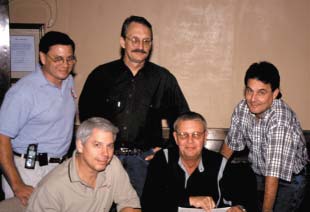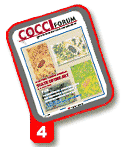COCCI Focus - Seizing the Opportunity
Townsends takes the Arkansas state motto to heart with innovative health program
!--maintxt--> Think tank: Helms (second from right) reviews health program with (left to right)
Kohler, Rutledge, Hargis and Tulley.
|
If you travel to Batesville, Ark., in
the northeast part of the state, you'll
find yourself in scenic White River
Valley near the foothills of the Ozark
Mountains.
With a population of 11,000, the
community holds the distinction of
being the second oldest town in a state
that calls itself the "Land of
Opportunity."
The locals say teamwork, community
spirit and pride thrive in Batesville.
So, apparently, does innovative poultry
production. Just ask Doug Helms, live
production manager for Townsends,
Inc.
Helms and his management team
have achieved success in the broiler
business in recent years. While production
statistics are kept confidential,
Helms says both chick quality and flock
health remain high, with low mortality.
According to industry tracking services
that maintain producer anonymity,
Townsends now ranks among the top
U.S. companies based on ready-tocook
pounds per week.
Key Player
Townsends has been a key player in
the U.S. poultry industry since the late
1940s. Headquartered in Wilmington,
Del., the firm maintains two production
centers, one in Siler City, N.C., and the
other in Batesville.
All of Townsends's Arkansas production
is conducted by some 200 contract
growers within 75 miles of the
main office. Contract farms accommodate
from 20,000 layers to 120,000
broilers. Typical broiler houses run
18,000 square feet.
"We place about 950,000 chicks
with our contractors each week," says
Helms. Other key Batesville employees
include hatchery manager Dave Kohler,
breeder manager Bill Tulley and broiler
grow-out manager Bruce Rutledge. Dr.
Spangler Klopp, based in Georgetown,
Del., serves as corporate veterinarian.
Townsends' Arkansas operation
includes a company-owned processing
plant and 1,000 full-time employees.
Broilers are raised to 8 weeks of age
and processed at over 6 pounds of
body weight. All of the meat is
deboned and sold under various commercial
labels throughout the United
States and several foreign countries.
Like many poultry firms, Townsends
utilizes outside consultants, including
several veterinarians and local nutritionist
Dr. Phillip Hargis.
"None of us has all the answers,"
Helms points out. "Our consultants
provide another set of eyes and another
opinion to help us continually finetune
our production protocol."
Health Tools
For the past 7 years, under Helms's
leadership, Townsends has also developed
an effective disease-control program
built around vaccination. For
starters, the firm vaccinates for
Newcastle disease, bronchitis, Marek's
disease, reovirus and Gumboro.
"Not every company vaccinates for
these diseases, but it has worked well
for us to do so," says Helms.
"We have used (in-feed) coccidiostats
to control coccidiosis for several
years," Helms adds. "With the
development of the commercial live
oocyst vaccine, Coccivac-B, along with
the spray cabinet for application, we
acquired another tool to control the
disease."
For the past 5 years Townsends has
maintained five cycles of birds each
year. During this time the firm has vaccinated
for coccidiosis from late spring
to early fall, while providing coccidiostats
in the feed during the other
months.
"In our particular operation, we
derive the greatest benefit from that
particular coccidiosis preventative
schedule," Helms mentions.
Besides the feed budget, the cost to
protect Townsends' birds against coccidiosis
is one of the company's biggest
expenses "about 0.8 cent per chick,
Helms says.
"We consider the coccidiosis vaccine
a cost-effective tool and we use it
as such," Helms emphasizes.
Vaccine Cost Benefits
"We use coccidiosis vaccine for two primary
reasons," says hatchery manager
Kohler. "First, it's more economical to
vaccinate than it is to add coccidiostats
to the feed. Our economic benefits are
so great due to feed cost savings, that I
believe every poultry producer should
be using a coccidiosis vaccine protocol
to improve his or her bottom line."
Since there are as many different
management and processing regimens
as there are poultry producers, it would
be difficult and inappropriate to say
how much money a firm could save
each year by using a live oocyst coccidiosis
vaccine, says Townsends veterinarian,
Dr. Klopp.
"But the use of Coccivac-B is definitely
an economically viable concept,"
he says.
According to Klopp, Townsends
also uses coccidiosis vaccine because it
"seeds" the operation with Eimeria
strains that are more susceptible to
older ionophores and chemical treatments.
"After a 6-month cycle of using the
vaccine, we usually experience a boost
in performance from the ionophores,"
Kohler says. "That's because the
ionophores are then better able to protect
against cocci, because of less resistance.
"If we do get a coccidiosis outbreak,
it is easier to treat and control because
the oocysts we have been vaccinating
with are more susceptible "less resistant
"to treatment," he adds.
Management Notes
According to live production manager
Helms, litter management also helps to
ensure the success of a coccidiosis vaccination
program. "We make that a top
priority," he adds. "All of our broiler
houses are cleaned out and disinfected
twice a year, spring and fall."
"We really appreciate the ease of
application the vaccine spray cabinet
offers," Kohler mentions. "No other
form of coccidiosis control is as userfriendly."
What about chick coverage with the
vaccine?
"Nearly perfect," Kohler reports.
"We normally get greater than 95%
'takes,' and we often get as high as
98%. Since no vaccine is 100% effective,
we don't concern ourselves with
the small percentage that doesn't get
covered."
According to Dr. Rick Phillips, a
Schering-Plough Animal Health veterinarian
based in Louisiana, the red dye used in Coccivac-B helps hatcheries
monitor vaccine coverage. "It is
believed that the chicks preen and
ingest the vaccine orally," Phillips says.
Adds Helms, "With the spray cabinet,
chicks are exposed to coccidiosis
at an early age, so I am confident that
immunity is established uniformly."
Townsends vaccinates for coccidiosis
4 days a week, and the 6-hour
process to handle some 237,500 birds
normally begins at 4:30 am.
The spray cabinet is checked several
times during each of these four vaccinating
cycles to make sure the system
is administering the vaccine at the
proper rate, which is 21 ml per box of
100 chicks.
"With our nozzle tips, we maintain a
spray pattern from side to side and end
to end inside the crates to make sure
that the birds are totally covered,"
Kohler says.
Moreover, the spray cabinet is
checked thoroughly once a week for
routine maintenance and air pressure
calibration.
Right Tool, Wrong Approach
There are no negative results associated
with a properly designed and
implemented coccidiosis vaccine program,
Kohler asserts. But he is quick to
point out that mismanagement can
have a major impact on the success of
the program.
"It's critical to use the vaccine at full
dose," Kohler explains. "I know some
companies that have tried cutting the
recommended dose, but that plan just
won't work. You have to administer
one full dose for each bird to get optimum
results."
"If you use any less than a full dose
for each bird, you won't get optimum
results and you'll create problems that
will come back and haunt you," Kohler
emphasizes. "Cutting the dose results in
hit-and-miss vaccine takes, and you'll
get some coccidiosis breaks you would
not have gotten if you had followed the
manufacturer's recommended protocol."
Producer panic can be another
major hurdle to vaccination program
success, Kohler adds. Some companies
will vaccinate chicks correctly, but as
soon as they see the birds exhibit a
reaction such as lesions, they hit them
with an anticoccidial, he observes.
"That knocks out the immunity the
vaccine provides," Kohler says. "If producers
follow the manufacturer's directions
and just let nature take its course,
the vaccine works like a charm."
Source: CocciForum Issue No.4, Schering-Plough Animal Health.







